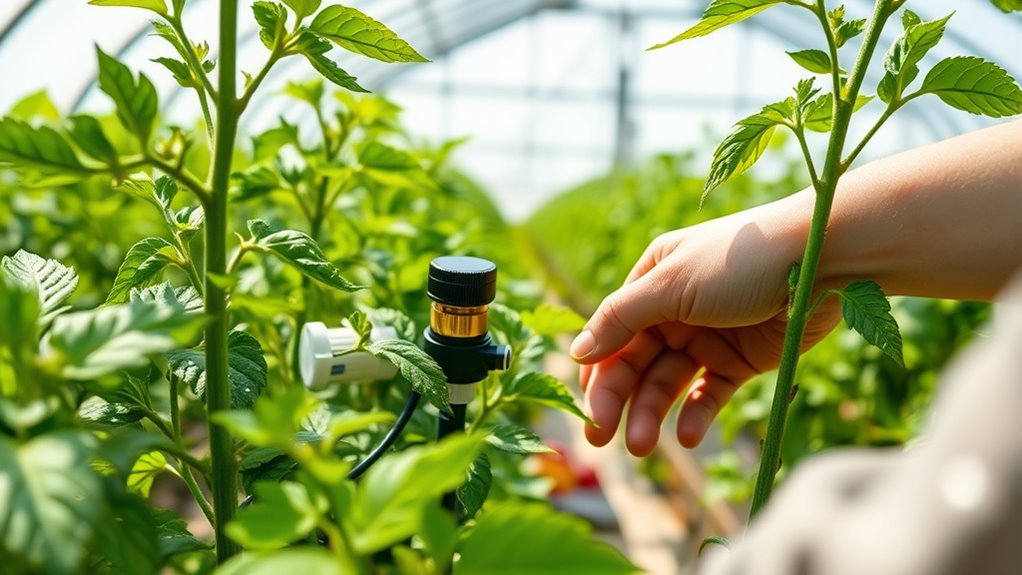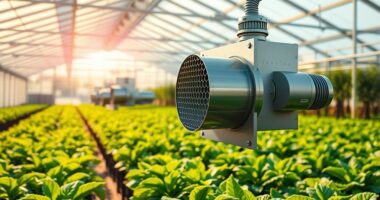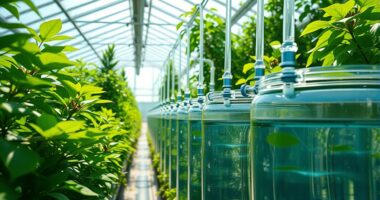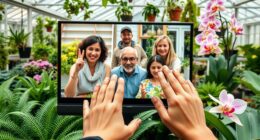To save water in your greenhouse, use drip irrigation to deliver water directly to plant roots, reducing waste. Collect rainwater from roofs to create a reliable, eco-friendly supply, and keep backup tanks for dry periods. Mulch around plants to retain soil moisture, and water during cooler times to minimize evaporation. Monitoring soil moisture helps avoid overwatering. Implementing these strategies can boost efficiency and sustainability—continue exploring for more tips to optimize your water use.
Key Takeaways
- Install drip irrigation systems to deliver water efficiently directly to plant roots, reducing waste and evaporation.
- Collect rainwater from greenhouse roofs using gutters and storage tanks for sustainable, cost-effective watering.
- Use mulch around plants to retain soil moisture, decreasing the frequency and volume of watering needed.
- Schedule watering during cooler parts of the day, like early morning or late evening, to minimize evaporation.
- Regularly monitor soil moisture levels to prevent overwatering and optimize water use efficiency.

Greenhouse growers can considerably reduce water usage by adopting simple, effective strategies. One of the most impactful methods is implementing drip irrigation systems. Unlike traditional watering methods, drip irrigation delivers water directly to the base of each plant, minimizing evaporation and runoff. This targeted approach ensures plants receive consistent moisture levels, reducing waste and promoting healthier growth. It also allows you to control watering schedules precisely, avoiding overwatering or underwatering, which can harm plants and waste resources. Setting up a drip system might require an initial investment, but the long-term savings on water and labor make it well worth it.
Another highly effective strategy is rainwater harvesting. By capturing rainwater from greenhouse roofs, you create a sustainable water source that can be used during dry periods. Installing rainwater collection systems, such as gutters connected to storage tanks, is straightforward and cost-efficient. Once in place, you can fill your tanks with minimal effort, reducing reliance on municipal water supplies. Rainwater harvesting not only cuts down on water bills but also helps conserve local water resources, especially in areas prone to drought. To maximize efficiency, ensure your collection system has filters to prevent debris from entering storage tanks and consider incorporating a first-flush diverter that diverts initial runoff containing pollutants.
Implementing reliable backup water sources like stored rainwater or supplemental irrigation systems can further enhance water security during unexpected dry spells or system failures. Combining drip irrigation with rainwater harvesting creates a powerful duo for water conservation. You can store rainwater and then use it in your drip irrigation system, ensuring your plants get clean, chemical-free water. This synergy reduces dependence on municipal water and promotes sustainable growing practices. To enhance this setup, regularly check and maintain your rainwater harvesting system, making sure tanks are clean and free of algae or sediments. When using rainwater, it’s also helpful to monitor soil moisture levels to prevent over-irrigation, which can lead to water waste even with efficient delivery systems.
Beyond these core strategies, consider scheduling watering during cooler parts of the day, such as early morning or late evening, to reduce evaporation further. Mulching around your plants also helps retain soil moisture, decreasing the frequency of watering needed. By taking these steps, you not only conserve water but also create a healthier environment for your crops, reducing your overall environmental footprint. Implementing drip irrigation and rainwater harvesting might require some effort upfront, but the benefits of lower water bills, healthier plants, and a more sustainable operation make it a worthwhile investment for any greenhouse grower committed to water efficiency.
Frequently Asked Questions
How Can I Measure Water Savings Accurately Over Time?
To measure water savings accurately over time, you should regularly calibrate your sensors to guarantee precise readings. Use data logging to record water usage consistently, making it easier to track changes and identify patterns. Monitor your data frequently, compare readings before and after implementing water-saving measures, and adjust your practices accordingly. This approach helps you get a clear, real-time picture of your water conservation efforts’ effectiveness.
What Are the Costs Associated With Implementing Water-Saving Technologies?
Implementing water-saving technologies involves initial investments like installing drip irrigation systems or moisture sensors, which can vary based on size and complexity. You should also consider ongoing maintenance costs, such as replacing filters or calibrating equipment regularly. While the upfront expenses might seem high, these investments often lead to significant savings over time through reduced water use and lower utility bills, making them cost-effective in the long run.
Are There Specific Water-Saving Practices for Different Greenhouse Crops?
Imagine your crops thriving with just the right amount of water. You can achieve this through crop-specific irrigation, tailored to each plant’s water requirements. For instance, leafy greens need less water than flowering plants. By customizing watering practices, you not only save water but also boost growth. Knowing your plants’ unique needs allows you to implement precise, efficient watering strategies that maximize yield and conserve resources.
How Do Weather Conditions Influence Water Conservation Strategies?
Weather conditions greatly influence your water conservation strategies. You should use climate adaptation techniques to adjust your watering schedules based on temperature, humidity, and rainfall patterns. Rely on accurate weather forecasting to plan water use efficiently, avoiding overwatering during rain and reducing irrigation during cooler or wetter periods. By tailoring your practices to current weather, you conserve water and guarantee ideal crop health without waste.
Can Water Reuse Be Effectively Integrated Into Existing Greenhouse Systems?
Think of water reuse like turning the tide in your favor. You can effectively integrate water recycling into your greenhouse by installing drip irrigation systems that capture runoff and reuse it efficiently. This approach minimizes waste and conserves resources, aligning with sustainable practices. By adapting your existing setup with these systems, you’ll boost water efficiency and reduce costs, all while nurturing your plants more responsibly.
Conclusion
By implementing these water-saving tips, you’re planting seeds for a more sustainable future. Think of your greenhouse as a delicate ecosystem—every drop of water is a essential ingredient in its growth. When you conserve water wisely, you’re nurturing your plants and the environment simultaneously. Embrace these practices like tending to a precious garden; with care and attention, your efforts will flourish into a thriving, eco-friendly operation that benefits everyone.








